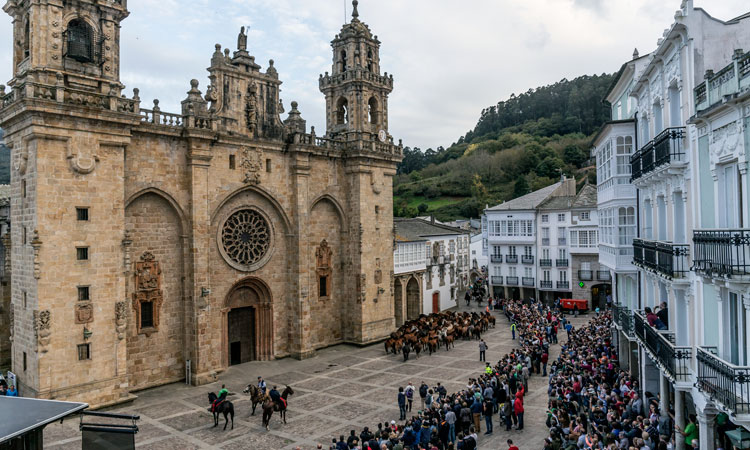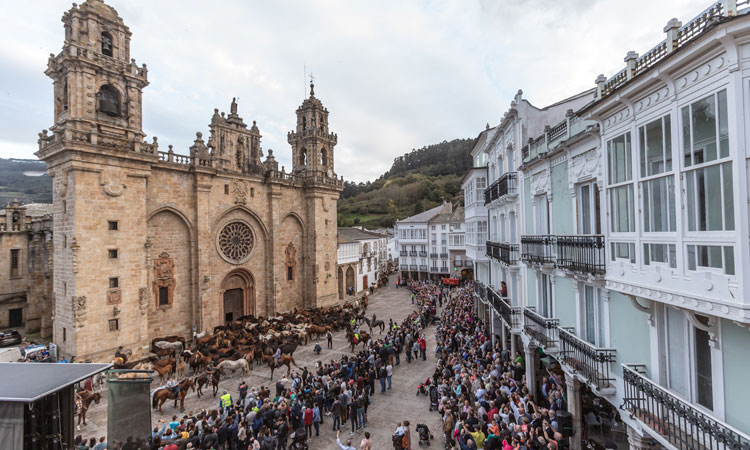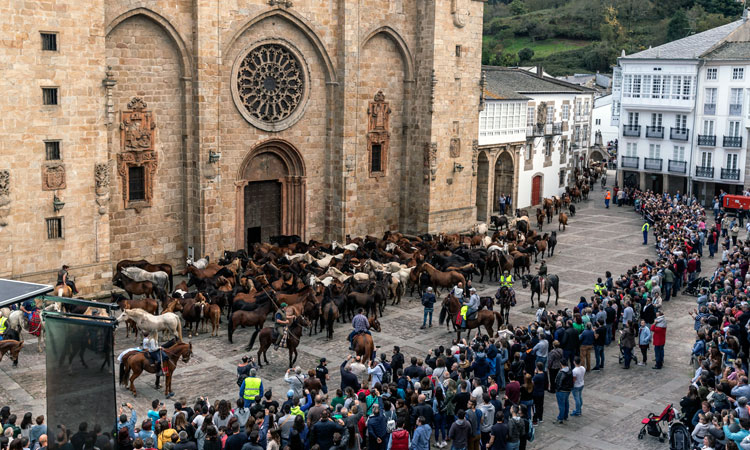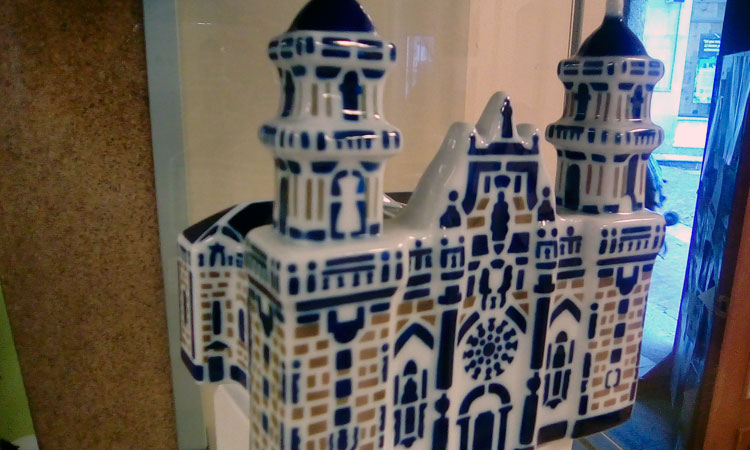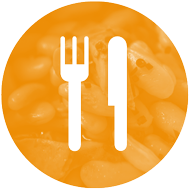If anything characterises the Terras de Miranda it is its farming spirit, and above all, the century-old horse fairs like those of As San Lucas, As Quendas or As Maulas, which you can still attend.
Recommended season: All year /Summer (Rapas das bestas) / Spring / Autumn (livestock fairs) / Winter (stews, broths)
Time: 3 days
We take you through:
- Mondoñedo
- O Valadouro
- Ourol
- Vicedo
- Viveiro
- Xove
- Cervo
- Burela
- Foz
- Barreiros
Did you know that?…
The baptism name of the bells of Mondoñedo cathedral is very curious! Paula de la Asunción, known only by “A Paula”; María Jacoba Concepción, “A Prima”; Ronda Rosenda Mª Natividade, “A Ronda”; Martina de Jesús Mª y José, “Esquilón Vello”; Gonzala Luciana de la Expectación, “Esquilón Novo”; Petra, the “chiming bell”, which was played so that there would be a good childbirth,… If you find yourself with the bell ringer, ask him about the symbolism of these bells. He is a great expert!
Paradas
October is the month of As San Lucas, known as “the fair of the fairs” because of the importance it had and still has in its area. It is primarily dedicated to untamed livestock. It has been held since 1156 and is considered the oldest in Galicia and one of the oldest in Europe.
In better times it lasted for up to fifteen days but now the average is five days starting on the 17th October. This day, at 1.00 p.m. the tolling and ringing of ‘A Paula’ -the largest bell in Mondoñedo cathedral that weighs 2,500 kg- marks the beginning of the fair which is then accompanied by the rest of the chimes from the bell tower.
In the evening, at around 5.00 p.m., the farmers -who have been rounding up the wild horses from the hills for several days- lead the herds in front of the cathedral to the field. It is a very exciting moment because the emotion of the organisers, neighbours and visitors can be felt in the air.
As Quendas is held in May. It originates from the 16th century and as it lasts 3 days; it can be classified as a small San Lucas fair. The programme is completed with a horse riding route to get to know the territory with some gastronomic days during wich local restaurants and bars offers horse meat.
The third date with the livestock tradition of Mondoñedo is in June. A ‘rapa das bestas’ has been held in the Campo do Oso since 1976.
Throughout the year, in addition to sampling dishes prepared with meat-based products, you can also participate in some of their preparations.
The ‘rapa das bestas’ is also held here, although in August. One of the cornerstones, and perfect ending, is the horse race between the best riders in the region.
Very close to the pen, visit the dolmen of San Tomé, with four supports. The ‘mámoa’ (prehistoric tomb) is very well preserved, but what will really catch your eye is a botanical rarity that is only found in a handful of places in Galicia: a luminescent fungus known as “elf’s gold”.
The Prado das Chantas, an oval structure formed by about 250 granite menhirs that have an imprecise origin, is also found in San Tomé.
The Pozo de Odesa is also worth a visit, an almost unknown waterfall embedded in the rock.
Ourol is a gem for ecotourism due to the variety of its ecosystems. It is located in the upper reaches of the river Landro (which flows into Viveiro), in the Sor valley and on the northern slopes of the O Xistral mountain range. These mountains were solely exploite for extensive cattle farming; cows and horses that, even today, graze in freedom.
The popular ‘churrascada’ (a kind of barbacue) is held annually on 24 July. You can also find the preserved remains of the old “Ferrería de Bravos”, a 15th century manor house.
The Festival of Rural Tourism takes place every third Sunday of July at the viewpoint of the Muronovo wind farm. A day which combines the exaltation of the surroundings with beautiful views over the area, tasting of local products, horse racing, dances,…
May is the month of the As Maulas Fair with at least three centuries of history. One of is great moments is the horse races although there is no shortage of the days for sampling pork products, the popular market and the livestock fair.
The Rapa das Bestas of Candaoso (Festival of Tourist Interest of Galicia) takes place in the parish of San Andrés de Boimente in July The ‘rapa’, considered one of the oldest traditions in Galicia, is to cut the tail and mane of the wild horses to clean them up.
Very close to the Candaoso pen (curro, in Spanish), within the limits of Viveiro and Xove town council, is the Pozo da Ferida which deserves a visit; a beautiful natural waterfall with more than a 30 metre drop. The Souto da Retorta is a natural monument where the so-called ‘Avó de Chavín’ (grandfather) is found; it may be the tallest tree in Spain and one of those with the largest spread in Europe and the largest eucalyptus in Galicia.
In the recreational area of Mount San Roque (300 m), a few kilometres from the centre and where the Romería of the same name is held, there is an animal park with donkeys and ponies. This is a fabulous viewpoint over the Viveiro estuary, the coast, the urban centre and A Coelleira island, in O Vicedo (west).
There are two important appointments in Xove. The Fair of San Isidoro do Monte, in Penas Agudas, is one of the most characteristic calls of the A Mariña region. It takes place in August and a few months before, in May, the Cattle Horse National Fair, with exhibitions, competitions, etc. is celebrated in Lago. A ‘must’ gastronomic appointment is the ‘Lacón’ Fest in March.
In Penas Agudas you will also find the megalithic heritage: the Petroglyph of Monte (Asset of Cultural Interest) was the first inventory in Xove.
If you like hiking, the Pau da Vella route ambles mostly through the communal grazing lands of the Costa of Laxamoura’s community of owners, where you will be able to see wild horses. The central point is the mount of Pau da Vella, a place where four town councils (Xove, Viveiro, Cervo and O Valadouro) come together.
A pork tasting takes place in Souto de Cervo square in mid April and in October you’ll have to make a note of the Potro (colts) route. Over the years, this event has become an annual meeting for riders associations from all over the region of A Mariña and even from other parts of Galicia to bring together a hundred registered participants.
One of the stops on the Monte Castelo Riding Route, in May, is the recreational area with the same name. In addition to the beautiful panoramic view over the coast line (the Cantabrian level begins or ends in Burela), here you will find History.
Nearby there is the ‘castro’ settlement of Chao do Castro (not excavated), where the famous torque of Burela was found. This prehistorical jewel is a rigid gold necklace and distinctive ornamental element of power or wealth that is represented in the municipal coat of arms. It is the largest of the torques found in Galicia and is kept in the Provincial Museum of Lugo.
At the traditional A Espiñeira Cattle and Horse Fair, in the parish of Vilaronte (June), there are a number of livestock prizes and the traditional ‘andadura’ competition.
To eat, opt for traditional meat dishes of the area and to burn off all that food, visit the basilica of San Martiño de Mondoñedo, the oldest cathedral in Spain (6th century), or climb to the A Frouxeira peak (430 m), if you are very adventurous! This is an excellent viewpoint over the Foz estuary, the boundaries of Alfoz and O Valadouro and headquarters, in the past, of Mariscal Pardo de Cela’s fort (you will see the ruins).
San Rosendo Fair, in the parish of San Miguel de Reinante, takes place in March, at the start of Spring, being a good time to taste traditional meat dishes.
A curiosity. In this same parish you will find what is known as the ‘Galician Stonehenge’: the archaeological site of A Roda (Bronze Age), which is unique in Galicia and in Spain.
It is also worth visiting the natural and archaeological area of Santo Estevo do Ermo, where you will find the chapel, forest and waterfall of the same name, as well as fountains with healing properties and the horseshoe of Saint James the Apostle’s horse surrounded by an indigenous forest made up from oaks, chestnuts birches or laurels. Do you know how to identify the trees due to their size and leaves?





